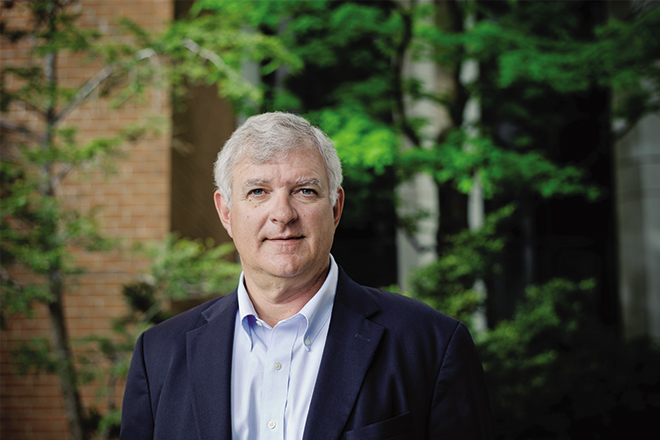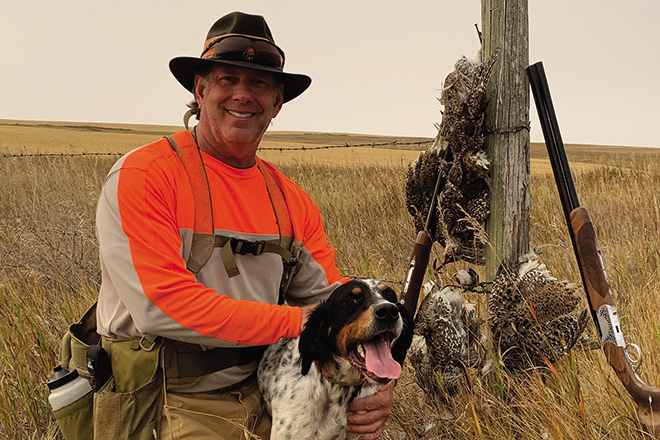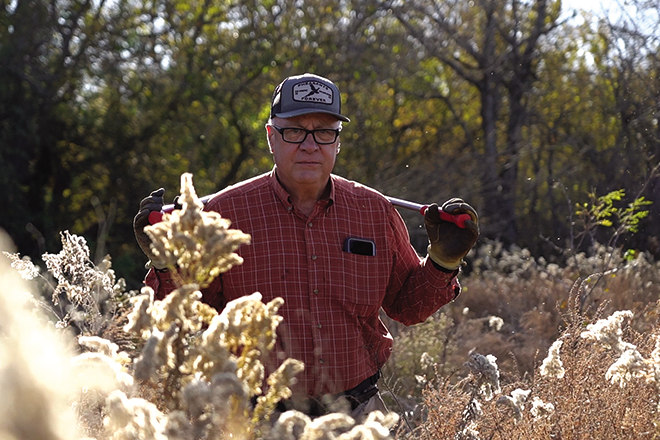By Andrew Johnson
Along with the call to experience the uplands comes the call to care for them. Here are three stories of extraordinary individuals who have helped lay the financial foundation of Quail Forever’s first-ever national fundraising campaign,
Call of the Uplands®
STEVE MARITZ
CALL OF THE UPLANDS® CONSERVATION ALLY — $100,000 - $249,999
Steve Maritz has always had a love for the outdoors, but his passion for hunting and conservation wasn’t stoked until later in life.
“I didn’t really grow up a hunter, but I spent a lot of time outdoors as a kid,” Maritz recalls. “I always enjoyed firearms, as well, but the two didn’t come together for me until I was in my 30s. I was living in Detroit at the time, and we got involved with put-and-take bird hunting for some of our clients. I really got a kick out of that, and thus began a conservation journey for me.”
 Member Photo
Member Photo
Today, Maritz hails from St. Louis, Mo., where he’s chairman and CEO of Maritz Holdings, which is made up of subsidiaries focusing on everything from marketing and creative communications to loyalty programs and meeting solutions. If you ask him where home is, though, he might point you a little over an hour southwest to a 1,600-acre tract that sits nestled in the foothills of the Ozarks.
“I ended up buying some land here in Missouri — it’s quite a beautiful spot along the Meramec River — that we now manage for quail and other species,” Maritz says. “That’s where I became involved with conservation more broadly, and it’s been a labor of love for me ever since.”
More specifically, through working his own land Maritz says he’s seen first-hand the positive impact prescribed fire has on habitat. He credits Scot Mikols, the biologist in charge of managing his land, for introducing him to prescribed fire. He also says Mikols has helped spearhead an effort to promote fire across eastern Missouri. It’s an effort Maritz wants to build on.
“I want to see fire become a common management tool, because when used correctly it not only improves habitat for quail and all other wildlife, it also helps improve overall ecological health,” Maritz explains. “But if you want to promote fire, you have to tell people the story.”
And Maritz plans on doing just that, as the financial gifts he’s made to Quail Forever come with the mission of promoting prescribed fire and educating people about its positive effects throughout Missouri. To that end, his contributions will be used to hire a prescribed fire coordinator to work with the Missouri Prescribed Fire Council and prescribed burn associations, or PBAs, throughout the state.
In short, PBAs are landowner-led groups designed to put fire back in the hands of those who own the land. They are essential in Midwestern states such as Missouri where a majority of the land is privately owned, as they empower landowners to work in concert with state, federal and nonprofit organizations such as PF & QF to maintain and restore upland and grassland habitat.
Funds from Maritz’s gift will also purchase equipment and fund training for PBA members, and Missouri PF & QF is working to leverage the funds with other gifts and grants to fund on-the-ground fire crews to safely put more fire on the land for natural community management and wildfire risk mitigations.
Maritz is also the father of three grown men, ages 30, 27 and 24, who all enjoy hunting and the outdoors. More importantly, Maritz says, is the fact they have all been indoctrinated to the conservation ethic. “Of course I want to put more birds in the air to shoot, but it becomes much more meaningful than that when you start thinking about your kids and the legacy you want to leave,” he concludes. “As humans we have the unique ability to affect our environment, and it’s important we do so consciously. We all need to step up and do our part, and I guess I want to be known as a guy who’s really pushing fire in Missouri.”
STEVE SHAFER
CALL OF THE UPLANDS® CONSERVATION DEFENDER — $250,000-$500,000
“My dad was a bird hunter — a quail hunter, to be more specific,” says Steve Shafer, who grew up in Palmetto, Florida, which sits just below Tampa in the west-central part of the state. “He hunted other things, but birds were always at the top of his list. Dad had a white F-100 Ford pickup, and he’d load the dogs up in back and he always took me with. I have never not known there to be hunting, and I have him to thank for that and for passing on his passion for the outdoors to me.”
Today, Shafer dabbles in real estate and is also the CEO of Sunsect, which produces a patented, dual-action product that acts as both insect repellent and sunscreen. The company is located in Tallahassee in Florida’s panhandle, just over a four-hour drive north from where Shafer grew up chasing wild quail with his dad across Manatee County.
 Member Photo
Member Photo
But the road Shafer has taken from simply being a consumer of the outdoors to being a hunter-conservationist took years to travel.
“What I’ve come to realize is that most hunters go through phases, and back then it was all about killing for me,” he admits. “I stayed in that hunting/killing phase into my early 30s until one day I was out turkey hunting and just felt there’s gotta be more to all of this.”
“So I got talking to an older gentleman who was a mentor of mine, and he told me I should go to a National Wild Turkey Federation banquet,” Shafer continues. “I had no idea what that was at the time, but I still went and ended up winning some guns and had a great time.”
From there, Shafer became heavily involved with the NWTF, first with the local chapter and eventually as the state chapter president for a few years.
“After a while I started looking for something a little different by doing some research online, and I saw there was an event called Pheasant Fest being held in Kansas City,” he recalls. “I thought, ‘what the heck is Pheasant Fest?’ I go pheasant hunting every year, so I thought I’d check it out.”
“That started my involvement with Pheasants Forever and Quail Forever, and I quickly fell in love with the PF & QF model where money that’s raised locally is able to be spent locally,” Shafer explains. “That was unique and different, in my opinion, where local folks have control but also have a wider outlook on things.”
Shafer ended up diving headfirst into PF & QF’s programs, especially programs geared toward youth conservation programs and shooting sports. Today he sits on the steering committee for QF’s Call of the Uplands campaign.
“Getting kids involved in the outdoors has always been a big deal to me,” Shafer explains. “My dad started me in the outdoors, and when I had kids of my own it really put things into perspective and made me take action to ensure they had the same opportunities I had while I was growing up.”
Another reason Shafer stays so engaged with PF & QF is he wants to help return huntable populations of quail on public lands in Georgia and Florida. It’s a dream he knows will take a lot of work, but he believes it’s possible.
“It’s easy to write a check, man, and there’s a lot of people who can write them. But they often stop there and don’t give any of their time,” explains Shafer. “I believe time is the most valuable thing you have, and I remain driven by the fact that through certain Pheasants Forever and Quail Forever programs one person can absolutely make a difference, where all it takes is one person pushing an agenda item loud enough that others take notice.”
“That’s what keeps me going,” he says, “because I believe in the mission, I care enough to be loud about it, and I back it up with my actions.”
WILLIAM “BRAD” BRADLEY
CALL OF THE UPLANDS® HABITAT GUARDIAN — $1,000,000-$2,500,000
William “Brad” Bradley’s path through the uplands took a midlife detour. But eventually he found his way back.
“I was away from hunting for 30 years,” says Bradley, who is one of four cofounders of NIC, Inc., a publicly traded company that provides online services for federal, state and local government agencies and their constituents. “I was busy with a family and a career, and I wasn’t recreating by hunting. It wasn’t until two of my partners, who happened to be avid hunters, invited me along on a quail hunting trip that I remembered how much I enjoyed it.”
 Member Photo
Member Photo
Bradley grew up in northeastern Kansas, where he hunted as a boy. But he also recalls traipsing around land his grandfather owned in east-central Kansas and chasing quail — albeit not very successfully, he admits — from the Kansas River south to the Oklahoma border.
After more than three decades spent pursuing a successful career filled with accolades and charitable contributions too numerous to list here, Bradley’s return home and his reintroduction to the uplands not only stirred up a wealth of memories, but it also fueled a growing interest in upland conservation.
“I went off to work my way through college and establish a career, but ended up settling in the Kansas City area — right where I swore I’d never be — and now I own land a little over an hour away where I’m working to bring quail back,” he says. “After I became interested in hunting again, I started checking out conservation organizations. I was drawn to Pheasants Forever and Quail Forever because it was involved with upland bird hunting and was stronger and more focused on upland habitat and conservation than other things, which was definitely in line with my thinking.”
Today, Bradley’s conservation efforts are clearly evident on over 2,000 acres he owns and manages in eastern Kansas and western Missouri. He practices soil health principles on his cropland, holistic grazing on his pasture lands and uneven-aged management on his timberlands.
“Some of the ground is reclaimed mining land and other parts had been overgrazed or were overgrown with cedars. Slowly, I’m bringing it back,” explains Bradley, who admits he’s had to learn some patience along the way. “You start out trying to force — or at least I do, because I’m a forceful person — a response from the land and then you quickly discover that doesn’t work. Then you research and dig deeper about what’s going on, learning about all nature’s subtle actions at play, which leads you to back off and start trying to influence the land.”
Bradley continues to support PF & QF because he believes the organization’s mission is evolving as a “habitat influencer.” That closely aligns with his beliefs that agriculture and conservation go hand in hand. He says flexible habitat programs available through PF & QF enable landowners and land managers to massage habitat back into the landscape by working with nature rather than commanding it.
“If you farm or manage land in the proper way, I think you can stimulate and encourage wildlife instead of crowding them out,” he says. “Quail, for example, were living in these parts a long time before there were farms, so it comes down to how can you integrate what they like with what you like. Other farmers might think I’m messy because the areas that are in crops have cover crops in them, so they’re not neat, clean rows. Other areas of my land I’ve left filled with wild places, as there’s a lot of stuff out there that’s been there for a long time for a reason.”
“Here’s the thing,” Bradley says. “It might look dirty to our eyes, but not to the eyes of wildlife. I always try to keep that perspective in mind, because if you’re called to experience nature, you’re also called to care for it.”
Andrew Johnson reports and writes regularly for Quail Forever and Pheasants Forever. He lives in Tea, South Dakota.
The Call of the Uplands is Pheasants Forever and Quail Forever’s first-ever comprehensive national campaign. This represents a $500 million effort designed to enhance over 9 million acres of upland habitat, permanently protect 75,000 acres through fee-title acquisition and conservation easements, and to cultivate the next generation of conservationists by providing over 1.5 million Americans with outdoor experiences from the West’s expansive landscapes and the vast Great Plains, to the quiet southern pine woods. This campaign is our best chance to bring together dedicated citizens, hunter-conservationists, farmers, ranchers, and other partners with a common cause: A promise to conserve our uplands before it's too late.
This story originally appeared in the 2021 Spring Issue of the Quail Forever Journal
. If you enjoyed it and would like to be the first to read more great upland content like this, become a Quail Forever member today!